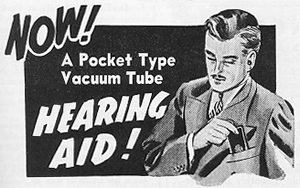
Washington University Medical Center

© CID - St. Louis
Pocket Aids
This photograph demonstrates how a "pocket aid" could be discreetly
tucked into one's pocket.
Sonotone Insignia
Decorative insignia to hide a hearing aid microphone styles were available
to camouflage the microphone.
Tie Clip Models
Hearing aids that clipped to a tie or a lapel were the first all-wearable
models of hearing aids.
SonoCharms
Insignia designs were soon incorporated into women's jewelry as seen
in this ad for "SonoCharms."
Acousticon "Wrist-Ear"
The Acousticon "Wrist-Ear," produced around 1955, was advertised
as a "revolutionary new accessory" as seen in this ad. Cords for
the wristwatches were concealed under the sleeves.

Telex Fountain "Pen"
The Telex 300 was produced in 1950 and, according to the ad, was
a "precedent shattering" model "to help keep your hearing
loss a secret from all the world."